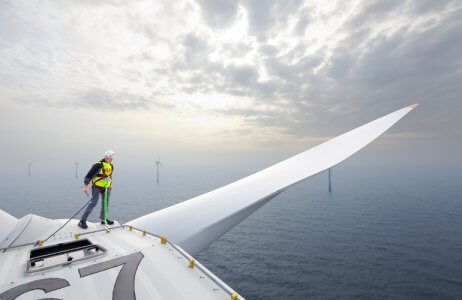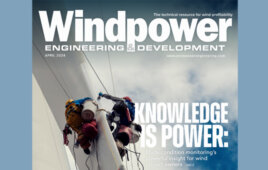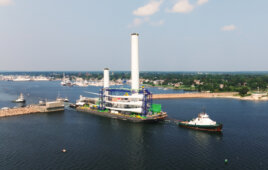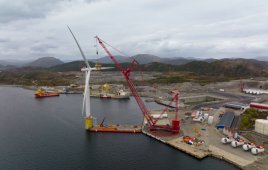By Chris Poynter, Division President, ABB System Drives
At 13 MW, the Haliade-X wind turbines that GE is supplying for the UK’s Dogger Bank Wind Farm are currently the most powerful in the world. However, the next generation turbines will push the power up to 15, 16 or even 20 MW. That means we are crossing the threshold beyond which low voltage (LV) systems could struggle to cope with the higher currents and losses in generators, converters and cables. This is driving a trend to medium voltage (MV) converters that can deliver the combination of performance, reliability and levelized cost of energy (LCOE) demanded by high-power offshore wind turbines.
 LV is certainly a simple and effective technology for use at lower power levels. It is also technically feasible at higher powers. The challenge is that the high currents involved require multiple converter modules to be connected in parallel. The space occupied by the converter system then increases roughly in proportion to its power. This has a knock-on effect in increasing the size and weight of the turbine nacelle considerably, as well as complicating the mechanical stability and the logistics during turbine erection.
LV is certainly a simple and effective technology for use at lower power levels. It is also technically feasible at higher powers. The challenge is that the high currents involved require multiple converter modules to be connected in parallel. The space occupied by the converter system then increases roughly in proportion to its power. This has a knock-on effect in increasing the size and weight of the turbine nacelle considerably, as well as complicating the mechanical stability and the logistics during turbine erection.
In industrial power applications it is well known that LV is most cost-efficient at low power levels, while MV is superior at high power levels. The same applies to wind turbines. As their power increases, MV converters become more competitive. The higher voltage means lower currents in the electrical drivetrain, which in turn enables the use of smaller cables along with a smaller converter footprint and less weight. In addition, MV converters boost overall turbine efficiency through the use of IGCT (integrated gate-commutated thyristor) semiconductor technology.
While the technical advantages of MV converters are clear, there are still challenges to their widespread adoption. The first is simply that there is only one driving force in renewable energy these days: how to make it cheaper than conventional power. That is manifested in increased price pressure on turbine manufacturers and their suppliers. Everyone talks about total cost of ownership (TCO), and that is of course an important consideration. Yet it is the initial capital cost that is most often the make-or-break factor.
 Proving the financial attractiveness of MV technology must take into account the investment costs for the complete electrical drivetrain. This includes the converter, switchgear, cooling systems, control and other ancillary equipment. Other associated costs, such as cabling and the impact of converter size and weight also need to be included in the calculation. Ultimately, this calls for a particular focus on value engineering to drive down costs to help customers stay competitive.
Proving the financial attractiveness of MV technology must take into account the investment costs for the complete electrical drivetrain. This includes the converter, switchgear, cooling systems, control and other ancillary equipment. Other associated costs, such as cabling and the impact of converter size and weight also need to be included in the calculation. Ultimately, this calls for a particular focus on value engineering to drive down costs to help customers stay competitive.
The second challenge is the need for exceptional reliability. For example, in a traditional wind farm of say 20 turbines, each rated at 3.5 MW, the failure of a single unit results in a 5% loss of output. But if that wind farm is replaced by five mega-turbines, then one turbine going offline will result in an unacceptable 20% loss of generation. At the same time, mega-turbines tend to be installed in more remote areas, further offshore, where it might not even be possible to gain access for maintenance for six months of the year.
 MV converters do have an inherent advantage with respect to reliability, as they employ fewer components than LV models. Manufacturers are working to take this to the next level with a focus on design for reliability. One small example is the use of self-healing components, such as capacitors that can restore their insulation properties after a breakdown. Encoders and fuses are also examples of components that tend to fail due to aging. MV converters can be designed to operate without encoders, using software control instead. In addition, fuses can be eliminated by operating with advanced breaker control algorithms.
MV converters do have an inherent advantage with respect to reliability, as they employ fewer components than LV models. Manufacturers are working to take this to the next level with a focus on design for reliability. One small example is the use of self-healing components, such as capacitors that can restore their insulation properties after a breakdown. Encoders and fuses are also examples of components that tend to fail due to aging. MV converters can be designed to operate without encoders, using software control instead. In addition, fuses can be eliminated by operating with advanced breaker control algorithms.
Ensuring reliability depends ultimately on extensive testing in close to real-world conditions and the collection of big data. Through digitalization, it is now possible to measure aspects that were never measured before, such as the temperature changes and switching rates of even the tiniest components. The detailed insight gained from testing and field experience is being built into onboard analytics for MV converters as the basis for remote condition monitoring. The benefit is that any potential reliability issues can be detected at a very early stage, enabling wind turbine operators to take preventive action before it causes a failure.
While MV converters are the future technology for the largest offshore wind turbines, they are already a well-established commercial proposition. In fact, ABB has over 200 units in current operation in the North Sea, Baltic and off the Chinese coast. This fleet is set to grow considerably over the next two years with the deployment of 95 units to GE Renewable Energy for installation at Dogger Bank Wind Farm. They will enable the 220-m turbines to produce a total 1.2 GW in the first phase.
LV converters will continue to dominate the majority of installations, especially onshore. In contrast, MV converters will always remain something of a niche and relatively low volume product. Yet in the very important niche occupied by the largest offshore wind turbines, MV is sure to emerge as the technology of choice.
 Chris Poynter is Division President, ABB System Drives. The System Drives Division is a global supplier of high-power, high-performance drives, drive systems and packages for industrial process and large infrastructure applications. In addition, the Division offers global support to help customers, partners and equipment manufacturers with asset reliability, performance improvement and energy efficiency in mission critical applications.
Chris Poynter is Division President, ABB System Drives. The System Drives Division is a global supplier of high-power, high-performance drives, drive systems and packages for industrial process and large infrastructure applications. In addition, the Division offers global support to help customers, partners and equipment manufacturers with asset reliability, performance improvement and energy efficiency in mission critical applications.
Chris joined ABB originally in 1980 working with industrial motion and power technology customers in marine, utilities and process Industries. He has held various senior management positions in ABB’s drives, process automation and service businesses, working in Australia, Canada and Switzerland. Chris holds a degree in Electrical Technology and an Executive MBA in Marketing.
Filed Under: Featured




